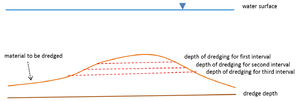CMS/DredgeModule
__NOTITLE__
CMS Dredge Module
In 2013, work began development of a dredging module for the Coastal Modeling System through Reed & Reed Consulting. This document references some of their descriptions and initial findings.
Introduction
Dredging of federal navigation channels is one of the primary missions of USACE. The Coastal Inlets Research Program (CIRP) has determined the need to implement a dredging module within the Coastal Modeling System (CMS). This module will greatly enhance the capability of the model to support the USACE districts in their planning efforts.
A FORTRAN code module has been developed in the CMS to simulate dredge activities, herein referred to as the Dredge Module. The Dredge Module encompasses the specifications of dredging areas, dredge disposal sites and operational rules governing the dredging. The module is based on the dredge module currently documented in the Delft3D-Flow User’s Manual dated September 2010 and provides the same simulation capabilities. The module has been developed using the current CMS-Flow code structure with a single file containing a variable definition (FORTRAN Module), card reading routine, initialization routine and routines necessary to implement the dredge simulations. The Dredge Module provides specific output to record the dredging rates and volumes occurring during the simulation. The Dredge Module has been implemented and tested in both the explicit and implicit solvers. The Dredge Module was designed so that it can be implemented in the current SMS 11.1+ version without GUI modifications. The module will make use of the existing advanced card capabilities and the data set creation capabilities for specifying dredge source and dredge placement areas. The module was developed in two phases. First, to accommodate single grain size simulations and, second, to extend the dredge module for use with multiple sediment grain sizes.
A dredging module interface has been developed for SMS version 13.0 and some modifications to the initial CMS Dredge Module code were made to accomodate the new interfact, but is backward compatible to the initial CMS file inputs and data files.
Overview
The dredge module is implemented in the CMS as a subroutine call from the explicit or implicit flow solver routines. The dredge simulation's primary interaction with the CMS is a modification of the morphology by adjusting the bottom elevation of cells that are in the user defined dredge areas or placement areas. When certain criteria are met, the bottom elevations of cells in the dredge area are lowered to simulate the removal of sediment and the bottom elevations of cells in the placement areas are increased to simulate the placement of the dredge material. A mass balance is maintained and it is also possible to represent conditions in which the dredge material is placed in upland areas or in areas not represented in the CMS grid domain. The simulation can also be configured to simulate the construction of dredge placement islands.
Implementing a dredge simulation in CMS consists of two primary setup steps:
- Define the dredge source and placement areas
- Define the dredge scenarios and operations
Dredge and Placement
Area Definition
The dredge and placement areas are defined by creating input arrays identifying the cells that are in each source or dredge area. These input arrays are similar to a bottom friction or hard bottom input file. The input arrays are each stored in XMDF binary files. ASCII format is not presently accepted, but will be implemented in the near future. Within each input array, the source or placement areas are defined as those cells with a non-zero value.
Triggering
There are presently four options for triggering dredging for a given scenario.
- If any cell in the source are has a bottom elevation above a user-specified threshold.
- If the volume of sediment above the dredge depth is above a user-specified threshold.
- If a certain percentage of the source area's bottom elevation above the dredge depth exceeds a user-specified threshold.
- Specification of a time window during which dredging can occur. Any dredge areas with elevations above the dredge depth will be dredged during the specified time period. Multiple time periods can be specified and each is defined by a start and end time by the user.
Order of Dredging

The options of dredging define the order in which cells are dredged to the specified dredge depth:
- The volume dredged during each interval is taken from the highest point in the source area first. This approach is depicted in Figure 1.
- A dredge starting cell is defined and the volume dredge during each interval is taken from the cell closest to the starting point first, and then dredging progresses to cells that are further away from the starting point. The starting point is user-prescribed by specifying the cell ID that contains the starting point.